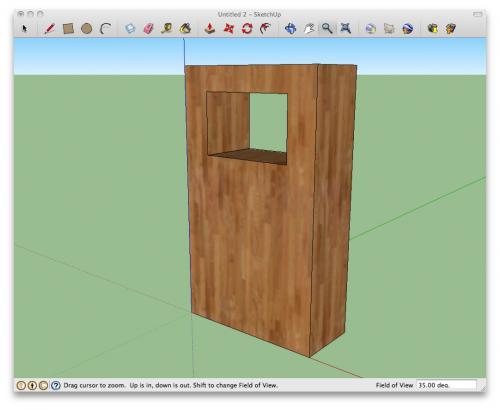[Update March 2010] In an update to Sketchup 7, you can now just go to File > Export > 3D Model and choose ‘COLLADA File (*.dae)’ as an option. This post remains as the information about extracting a KMZ file could be useful to some.
Google have just announced the release of SketchUp 7. SketchUp is a wonderfully simple 3D modelling package, often used to populate Google Earth with 3D models of famous buildings. SketchUp Pro is the paid-for ‘grown up’ version of SketchUp, allowing, amongst a range of features, 3D export of models in a variety of formats.
The free version of SketchUp only allows models to be saved in the proprietary .skp file format, and export to kml for inclusion in Google Earth. However, I noticed on the version comparison (Why go Pro) page, that listed in the 2D export feature list, that Collada (a 3D interchange format) export was supported. It’s strange to see it listed as a 2D file format, but there you go. This is exciting, as it means that the free version of SketchUp would be more usable to me (I can’t afford the $499 for the Pro version).

So, I downloaded SketchUp, and made a quick box model. I can do more complex models, honest!

The next step would be to export as Collada. Since it was listed as a 2D export format, I looked for it in the 2D export menu, but JPG, PNG and TIFF were the only options. So I checked the 3D export menu, which only listed KML and a tempting link to upgrade to Pro. The help menu didn’t seem to mention Collada export either. Initially, I put this down to an error by Google, and that this was indeed a Pro feature that had slipped into the free version’s feature list.
However, rarely one to give up, I decided to export the model as KML and see what I could do with it. I noticed that KML exports were KMZ files (a compressed file containing geometry and textures). On my Mac, I convinced Stuffit 10 to unzip the KMZ file to my desktop.

Stuffit created a directory containing the unzipped files. At first this just looked like it was a kml file and materials, but a quick look in the ‘models’ directory revealed a file with the extension .dae – which is the extension used by Collada files. So, through a rather backdoor method, it does indeed export Collada files. Which also means that Google Earth will read Collada files, which could lead to some interesting possibilities.
The next step is to test the exported file. I’m lucky enough to have a copy of E-On Software‘s Vue 7 Infinite at work, which supports the import of Collada files. Windows users of Vue are lucky enough to have a native .skp import, but it’s something us Mac users have to go without. Collada export neatly solves this problem.

It wasn’t that straightforward in Vue, however. The imported Collada file appeared to have no texture applied to it. A look in Vue’s material inspector revealed that for some reason the material had 100% transparency. Setting this back to 0% transparency showed my SketchUp-designed object, which I was able to render. Success!
While SketchUp Pro offers a lot more functionality, as well as plugins, the free version is still very useful for simple modelling tasks. Being able to export in 3D from the free version is a definite boon, and my use of Sketchup will definitely increase as a result.
I hope that this is of use to 3D artists out there – feel free to leave comments if you have any ideas on how to streamline the process.

Comments
5 responses to “Google SketchUp 7, 3D export, and Vue 7 Infinite”
tom, tx for the info, will send the link to our 3d fellow who is also a ‘tinkerer’ and will appreciate the howto!
Thanks for the tip, Tom! I use Vue 7 in my business, and write about it on my blog, above. I’ll pass this info along.
Cheers-
Bob
Hi Bob and John,
I’m glad the info might come in handy! I’m sure this will be of interest to any user of 3D software capable of Collada import – do spread the word.
Cheers,
Tom
Hi Tom!
Great news 🙂 I just tested the SketchpUp 7 on linux and run it with Wine (for running Windows software on Linux ), and thought I’d give your method a go, but it seems that I can’t run the .kmz-exporter… Well, i can run it, but it won’t output a file. I’ll look into it a bit more. It might have something to do with ruby scripts in general. Thanks for the info.
Hi. Appreciate the knowledge. Have you ever successfully imported topographic map data into vue? I’m really interested in trying to get topo elevation data from Google maps to re-create real places in a 3d model. I’ve tried the USGS for the area I want, but its in .hgt format and not .dem.
Thanks.